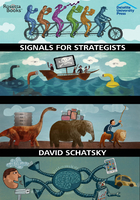POLITICAL America has become a land of short-term thinking. It doesn't plan far in advance, and it doesn't look far behind; public debate largely ignores both the lessons of history and the glaring realities of the future. We can choose to lay blame at the feet of any number of causes: our increasingly short attention span, the media coverage that plays to it, or the political pandering that preys on it. The fact remains that we must all act to correct it.
The first step is simply to start looking ahead-and farther ahead than the next news cycle, the next election, or even the next administration. The world is accelerating-the rate of change only increases every day-and we can't know the future. But we can start preparing for it. Any good plan begins with knowing our own values and goals. We must have a serious discussion about what we wish to see in the world, on how our economy and our government best serve our society. We can begin shaping the intellectual and political landscape, the frameworks and key policies, to serve the real needs of our families and businesses in the future.
In the essays that follow, the authors lay out powerful visions that require significant changes not only to our policies but also in our perspectives. Chapter 1, from the Economic Policy Institute, describes an economy of shared prosperity that puts the interest of all citizens first. Chapter 2, from the Roosevelt Institution, encourages investment in our shared future through renewed emphasis on critical public goods. To move from here to there will require not only government action but also moral leadership and widespread debate. But change is possible. We must look no further than ourselves.
1 Building Shared Prosperity
Lawrence Mishel and Nancy Cleeland
FOR the better part of three decades, our country has been stuck on a single, simplistic idea about the economy: less government equals more prosperity. American leaders have sought to create a marketplace unfettered by rules and regulations. Let people fend for themselves, they said, and innovation and entrepreneurship will flourish, the economy will grow as never before, and the benefits will eventually lift the fortunes of all.
That was the promise. We have seen-and lived-the reality. From 1989 to 2006, the highest-earning 10 percent of U.S. households collected over 90 percent of the nation's income gains. Today the top 1 percent of American families receives 23 percent of all personal income, up from just 10 percent in 1979. Corporate executives earn 275 times as much as average workers, compared with 27 times in 1973.
It's been a fine time to be a CEO or a hedge fund manager, in other words. But the great majority of Americans are less secure and hopeful than they were a generation ago. Jobs are disappearing. Real family incomes are falling. Retirement security is a fading ideal. Health care is becoming a privilege rather than an expectation. In the struggle to keep up with expenses (or avoid falling too far behind), Americans are working longer hours, borrowing more, and living closer to the financial edge.
By degrees, the United States has become a more economically unequal country than at any time since the 1920s, and the most unequal of all of the world's developed nations today. By that measure, in fact, we are drifting away from the relatively egalitarian pattern of Western Europe and the Pacific Rim countries and toward the orbit of Russia and Latin America.
This is not a safe path. Extreme inequality hobbles mobility, leaving poor and working-class Americans and their children with little chance to move into higher-paid and more rewarding jobs. The stress of constant financial worry among the majority stifles innovation and technological progress. In an economy that relies heavily on consumer spending, the shortage of disposable income makes a bad situation worse.
Our leaders used to understand the danger. "The welfare of each of us is dependent fundamentally upon the welfare of all of us," said a Republican president, Theodore Roosevelt, at a time not unlike our own, when the rich had been getting richer while workers struggled with low pay, unsafe conditions, and the ever-present dread of falling off a financial cliff.
Bit by bit, against fierce opposition, the reformers of Teddy Roosevelt's day succeeded in enacting an early set of consumer and worker protections. But it took additional decades and the Great Depression before the country was ready to put solid legal weight behind the ideal of shared welfare. That happened when another Roosevelt-Teddy's Democratic fifth cousin Franklin-pushed through the landmark legislation that we remember as the New Deal.
From the 1940s into the 1970s, leaders of both parties carried on the effort to promote broad-based economic security and opportunity. Although not all racial and ethnic groups benefited equally, the laws and programs that became the postwar social contract helped tens of millions of Americans enter a middle class that was the envy of the world.
Then came the harsh ideology (concealed in the sunny rhetoric) of the "Reagan Revolution." Since the early 1980s, Reagan and his heirs have hacked away at FDR's legacy. Years of deregulation, de-unionization, skewed tax policies, and lax enforcement of worker protections have tipped the scales in favor of corporate and financial insiders, and against the great majority of American workers and families. Those same policies have fed waves of financial speculation. In one of the most recent and destructive of these episodes, millions of Americans were talked into booby-trapped mortgages. Many now face the threat of losing their homes; others stand to lose much of their home equity wealth.
Clearly, the economy will be the first order of business for the new leaders who take office in January 2009. Just as clearly, the old answers- the familiar mix of tax cuts and fiscal and monetary tinkering-will no longer do. But America needs more than a new set of economic policies; it needs a new purpose for economic policy.
The mission before us is to build an economy of shared prosperity. That will mean taking steps to reduce economic insecurity and give Americans a chance to breathe easier and plan for the future without dread. Another key piece of a shared-prosperity agenda (discussed in the essay that follows) is public investment in our crumbling infrastructure, in education, and in job creation. Finally, we must shape a new brand of globalization that serves ordinary people in exporting and importing countries alike.
Most Americans grasp the need for bold action. Polls show a widespread recognition that the current economic model is not sustainable. But while the old mythology has failed disastrously on the ground, it still echoes powerfully in Washington and other centers of influential opinion; the push for an agenda of shared prosperity promises to be a mighty struggle. But the outcome will be worth struggling for: a world of less stress, more opportunity, greater mobility, more fairness, and renewed confidence.
We have every reason to expect that an economy of shared prosperity will be a stronger economy, too. "We have always known that heedless self-interest was bad morals," said Franklin Roosevelt, looking out on the damage wrought by the laissez-faire policies and corporate excesses of the 1920s. "We know now that it is bad economics."
We knew it then, and we know it now. This time, America must not forget.
Prosperity Ideas
Addressing Key Roots of Economic Insecurity
Skyrocketing health care costs are hurting U.S. businesses as well as families and individuals. The current system denies access to some forty-five million Americans while pushing costs higher than those in comparable countries. Employers faced with these rising costs are cutting benefits or passing on costs to their workers, who increasingly are forgoing health insurance altogether. Medical bills now account for half of all bankruptcies.
Retirement has also become increasingly risky for Americans, who can no longer count on the pension plans that were once a standard employment benefit. Today, a shrinking number of employers provide any sort of retirement plan, and those who do overwhelmingly favor personal accounts such as 401(k)s, which are managed by employees and often require matching contributions. Financially, the baby boomers are ill prepared for retirement: more than one-third of those fifty-five and older have less than $25,000 in savings, and a growing number are dipping into retirement accounts to fund routine expenses.
This double dose of risk is bad news for the overall economy as well as the individuals involved. But there are ways to rebuild stability into these two important features of life. The Health Care for America Plan, detailed in Chapter 7, combines employer-provided health insurance with a set of public plans to cover all Americans, at a net savings to national health spending. It reduces costs for responsible employers and puts all businesses on a level playing field.
A fix to retirement insecurity is also within reach. First, it should be recognized that Social Security, always designed as a supplement to retirement, is fully funded for decades to come. Raising the earnings cap-now set at a low $102,000-so that top earners contribute a fair share would eliminate shortfalls down the line. The system was originally intended to draw revenues from 90 percent of all wages; that ratio should be restored.
In addition, a plan known as the Guaranteed Retirement Account (GRA), authored by economist Teresa Ghilarducci of the New School University and released by the Economic Policy Institute, would augment Social Security payments so that all Americans can retire in dignity. The accounts would be funded by employer and worker contributions with a guaranteed payout after retirement. The new system would cut tax subsidies that mainly benefit the very rich in order to provide the retirement contributions for low-income workers.
Investing in Competitiveness
From the nation's earliest years, federal infrastructure projects-in such things as highways, railroads, electricity, and water systems-have helped fuel economic growth while improving the quality of life for all. But such investments have been woefully inadequate for years. The American Society of Civil Engineers estimates it would take $1.6 trillion over five years to bring the nation's bridges, dams, sewer systems, and other infrastructure up to good condition. Schools are also badly in need of public investment for repairs and maintenance. And we must invest money in broadband build-out, so that all parts of the nation can participate in technology-related productivity growth.
In addition to improving public health and safety, these projects have the added benefits of stimulating the weakening economy and creating millions of good jobs. For example, a $20 billion investment in school repairs would generate an estimated 250,000 jobs. To make the most of this approach, we must ensure that all jobs associated with this public spending offer fair pay as well as benefits and policies that allow for work/life balance.
We can also rebuild the nation's important manufacturing base while improving the environment by promoting jobs in the area of renewable energy. Having a comprehensive green job strategy involves not only doing the work but also ensuring that the components used to generate energy from the wind, the sun, and other alternative sources are made domestically. With the right policies, the United States can have a revitalized manufacturing sector that brings with it good jobs, rapid innovation, and environmental sustainability.
Reconnecting Pay and Productivity
Productivity has risen 20 percent since 2000, yet most benefits of that economic growth have gone to the very rich, while typical workers' incomes have stagnated or declined. The growing disparities reflect the declining power of workers to demand their fair share of growth. Several practical steps to restore the necessary economic balance between employers and employees are possible.
One is to restore the ability of workers to freely join unions by passing the Employee Free Choice Act (EFCA), which permits unionization if a majority of workers sign union cards. The benefits of union membership are clear: members earn 14 percent more on average than nonmembers and are far likelier to have a pension plan and health insurance.
The federal government also has an important role in this area. The Labor Department must return to vigorously enforcing and improving the laws that govern wages, hours, overtime premiums, and occupational health and safety. The minimum wage should be raised to match half the average wage (as it once did) and maintained at that level.
More fundamentally, we as a nation should set a goal of full employment, which in itself will empower workers. It is no coincidence that income grew and poverty rates fell across all population groups in the late 1990s, when a roaring economy created millions of jobs and briefly drove unemployment rates down to historic lows.
Boosting Trade and Prosperity: Home and Abroad
American workers are losing ground in the global marketplace, where corporate interests have trumped all others in rule making for international trade. The United States has shed seven million jobs tied to trade since the late 1970s, when imports began to grow faster than exports. Changes in technology and economic policy have facilitated the movement of jobs offshore, and now some 50 percent of all manufacturing production of U.S.-based companies is located in foreign countries. As outsourcing expands, globalization's losers extend well beyond the least educated and unskilled. The idea that trade's negative impacts could be reversed with job training and education clearly has not been born out.
A serious response to these trends must begin with public investment at home-supporting education, job assistance, and innovation. Meanwhile, we should declare a strategic pause in trade agreements and insist that any future agreements include provisions for enforceable labor rights. Another key step is to enforce current trade policies and to eliminate perverse tax incentives that favor overseas investments, and consider instituting value-added taxes that favor exports over imports, as other nations do. Finally, we should promote a more stable and equitable global financial system.
Authors
Lawrence Mishel is the president of the Economic Policy Institute (EPI), where he's worked since 1987. As EPI's first research director, then vice president, and now president, he has played a significant role in building EPI's research capabilities and reputation. A nationally recognized economist, he has researched, written, and spoken widely on the economy and economic policy as it affects middle-and low-income families. He is the principal author of a major research volume, The State of Working America (published every even-numbered year since 1988), which provides a comprehensive overview of the U.S. labor market and living standards.
Nancy Cleeland has been the external affairs director at EPI since early 2008. She is a Pulitzer Prize–winning journalist with an extensive background in labor, immigration, and international trade. During a decade at the Los Angeles Times, she covered major labor disputes, including a port shutdown and several regional strikes, and exposed harsh conditions faced by immigrant workers. She was a lead writer on a 2004 series about Wal-Mart's labor policies and sourcing practices that won the Pulitzer, Polk, and other prestigious awards. Earlier, she specialized in coverage of the U.S.-Mexico border and Latin America, including a three-year stint as the Mexico City bureau chief.
2 Investing in Our Future
Nathaniel Loewentheil
and Vera Eidelman
AMERICANS have always expected life to be better for the next generation. But now, according to recent polls, they no longer do. Imagine: for the majority of Americans, the past is brighter than the future. The American dream is becoming an American memory.
This pessimism reflects an alarming trend: as a country, we have stopped investing our resources in a shared future. In previous eras, a vision of a shared future united the country around great national initiatives. In the mid-1800s, federal legislation spurred the railroad boom, opening the country to a growing population. In the 1930s, the Tennessee Valley Authority permanently transformed an entire region, creating a completely new set of industries and opening a new way of life for millions. In the decades following the Great Depression and World War II, encouraged by our victories over great forces, we made even greater investments. Through legislation like the GI Bill and the early Highway Acts, we manifested a sense of collective power and interdependence not matched before or after. In the 1950s and 1960s, federal infrastructure investment peaked at almost 2 percent of the gross domestic product (GDP). At the same time, we spent 7 percent of our economic output on education and 2 percent on research and development. The results proved the power of public investment-in the decades that followed, the United States enjoyed one of the most remarkable periods of economic growth in world history.
But then a strange myth took hold, propagated by conservative thinkers and politicians, that all private spending was wise and productive, all public spending foolish and wasteful. Beginning in the 1970s, the federal government began deregulating industries, lowering taxes, and abandoning public investments in favor of the inviolable invisible hand. For the last thirty years, as conservatives are quick to point out, the economy has continued to grow. The market has provided private goods in abundance-as many cars and televisions as we could ask for. But without the hand of government and provision for public goods, we have fallen behind on the things the market cannot provide, things that secure our shared economic future: our children's education and our physical infrastructure. Today, infrastructure spending as a percentage of GDP has decreased nearly 50 percent since its peak. Education spending as a percentage of GDP has remained stagnant since 1969, while research and development funding has declined by half in the same time period.
Through a self-reinforcing set of public attitudes and government actions, we've largely abandoned our intergenerational responsibilities. The most important distinction isn't between public and private spending. It's between short-term and long-term thinking. We don't need to cut our spending; we need to invest more and more wisely.
The decline in national investments comes at a precarious moment as the United States engages in an increasingly competitive global economy. The country lost 3.3 million manufacturing jobs in the last ten years, and trade imbalances are equally disheartening. Even in areas of strength, the United States lags behind. We have become a net importer of high-technology products. Our national debt-the world's largest-is set to grow to almost $15 trillion in the next decade. Meanwhile, the economic growth rates of developing countries like China and India are nearly three times that of the United States.
The engines of the twenty-first-century economy will be made of the most refined materials, built by the strongest tools. America once had both: a fiercely competitive school system and the strongest industrial infrastructure in the world. Today, the situation is different. Many of our high school students never graduate, and too few of those who do are adequately prepared for college-level courses. Meanwhile, socioeconomic and racial inequalities remain staggering. When it comes to infrastructure, the $1.6 trillion in deferred maintenance noted in Chapter 1 makes for an equally grim situation.
Global competition. Investment gaps. Debt. These are reasons for serious concern. But as Franklin Roosevelt recognized at a time of far greater uncertainty, fear remains our greatest threat. Throughout the twentieth century, America stepped forward to confront the world's greatest challenges and succeeded. The current historical moment is one of great opportunity. If we meet it with a positive vision of the future, a plan for how to get there, and the faith and will to invest in ourselves, we will succeed.
Next is a set of proposals that will push our economy forward. Conservatives will argue that our country cannot afford public investments, but our short-term thinking is far more costly. Substantial investments in fundamental public goods-education and infrastructure-sustain a healthy free-market system. A twenty-first-century economy requires a world-class education system, an infrastructure that encourages sustainable development and innovation, and a country committed to its own future.
Investment Ideas
Teaming Together to Improve K–12 Schools
Creating a twenty-first century education system constitutes an enormous undertaking. It means investing capital in our schools and the materials necessary to equip them, increasing access to technology and broadband, developing more intelligent funding and taxation structures, and substantively revising our curricula. Furthermore, to significantly improve educational outcomes for low-income students, we must face up to systemic poverty and the impact it has on the lives of students inside and outside school.
But our investments will go only as far as the quality of teaching can take them. Teachers have proven time and again to be the most important in-school factor controlling educational outcomes. Our country needs a twenty-first-century teaching corps supported by the best ideas and resources we have to offer, one able to recruit our brightest to serve.
Young people are ready. Programs like Teach for America have proven that many high-performing college graduates are eager to teach. This new generation of educators can redefine education if we can keep them teaching. More than 20 percent of teachers leave within three years of entering, just as they become significantly more effective, while retirees account for fewer than one in six teacher departures. Each lost teacher costs schools approximately $50,000 in administration and training; the total annual cost of teacher departures nationwide is estimated at $4.9 billion. This does not include the cost of decreased educational outcomes, which may be up to three times as high.
Expanding Mentorship Programs
The first step toward building the teaching corps of the future is to better train and retain young teachers. Mentorship programs are one important approach with good models already in place. For example, through the University of California at Santa Cruz's New Teacher Program (NTP), experienced educators from around the country train with professionals and then serve as mentors for new teachers over the course of two years. The program costs only $6,500 per mentored teacher. Research has shown that the program has boosted morale, increased retention rates to 95 percent, and significantly improved educational outcomes.
This kind of mentorship program should be expanded. We propose a national Teacher Education and Mentorship (TEAM) initiative. The TEAM program would provide funding to grow and replicate programs like NTP, which would encourage collaboration between regional universities and K–12 schools, in 150 school districts. The success of the NTP program depends on careful planning and thoughtful training, and legislators must make provisions for careful implementation of TEAM, the total cost of which would be $150 to $200 million. However, by allowing for some flexibility in the 150 pilot programs, we could encourage the replication of best practices at a national scale (if and when TEAM results match or exceed those of existing programs).
As young people, we have seen firsthand the role that support networks play in our peers' career choices. Passionate as they may be to enter the teaching profession, recent graduates are anxious and inexperienced. Mentorship programs provide much-needed guidance and support. They are the most effective short-term way to increase young teacher retention and thus serve as the crucial first step toward increasing educational outcomes while decreasing unnecessary costs.
Encouraging Ongoing Public Education
Less than a third of today's American workforce holds a college degree. Yet, according to the Bureau of Labor Statistics, 42 percent of new jobs this decade will require one; less than three in ten did in 2000. We believe that all Americans deserve an education that will prepare them for a successful career, and more and more of those careers will require more than a high school education. It is our responsibility to provide ongoing education.
To significantly increase educational attainment, we must reorient our education system. Private colleges and state universities serve slightly more than half of those pursuing bachelor degrees and do so at an extremely high per-student cost. While we can and must reduce these costs, expanding this system on a large scale is not economically feasible. We must instead create a system for universal ongoing public education that builds off and expands our community college structure.
We envision a system in which entrance into community college is the standard course for high school graduates. Today, our system automatically enrolls eighth graders in public high schools, while leaving open private or charter alternatives. We propose expanding that system to automatically enroll graduating seniors in community college, leaving open the choice to enter the workforce, a private institution, or a four-year public program instead.
Such a system seems unobtainable by today's standards. But our standards today are outdated-we must redefine our conception of education for the new century. Ongoing public education will not require the costly construction of thousands of new community colleges. Many classes will be held early in the mornings and later in the evenings; we can take advantage of existing institutions like libraries, community centers, and public schools themselves. Instruction does not require intensive one-on-one classroom time. New studies have found that well-designed online learning modules can yield powerful results; the best courses were found to improve test scores in half the standard course time when used with limited classroom instruction. Combined with other innovations, like open-source textbooks and improved communication systems, these new tools can change the way we conceive of, and pay for, ongoing education.
We propose an Ongoing Public Education Network (OPEN) program. The Ongoing Public Education Network would strengthen ties between community colleges and high schools while simultaneously encouraging innovation and experimentation in online learning by
establishing $250 million in funding incentives for community colleges to expand continuity-of-learning programs between high school and college;
creating trial programs in fifty school districts to enroll all graduating seniors directly in fully funded continuing public education programs, at an estimated average cost per district of $325,800; and
providing a $200 million grant to top experts in education and computer science to develop a high-quality, online curriculum of fifty basic courses, which could then be distributed free directly to students and throughout the public community college system.
Rethinking Infrastructure
Public investments in infrastructure drive patterns of development, transportation, and private spending. In the last century, we invested in highways and roads, encouraging the market to create car-dependent systems. The result: less than 5 percent of our workforce uses mass transit to commute to work, and, taking into account the cost of road maintenance per driver, bus riders actually pay more for each mile traveled than do car users. It is becoming increasingly clear that our current transportation patterns are economically and environmentally unsustainable. We need to reform our policies to impose the true cost of driving on drivers while simultaneously creating attractive, viable public transportation options.
Drivers today pay less than half as much for each mile traveled as they did in 1959. More than fifteen years have passed since the gas tax's last nominal increase, and federal highway funding is expected to run dry by 2009. The gas tax is not only too low but also indirect. We need to tax drivers for the true social and economic costs of the pollution they cause and the wear and tear they impose on our public road system. We recommend replacing the indirect gas tax with a direct vehicle-miles-traveled fee to be paid by private vehicle users. A tax of 1.2 cents per mile would raise as much as the current gas tax revenue- the federal government must set this as a minimum and allow states to make further increases.
It will take more than higher taxes to get people out of their cars, though. Because of historical underinvestment in public transportation, many buses and subways lack the benefits that attract American consumers; the result is widespread psychological distaste for systems that are perceived as crowded, slow, unreliable, and dirty. We need to invest in creating comfortable, appealing transit systems and marketing them as twenty-first-century transportation solutions.
It begins with our buses. Buses currently account for more than 80 percent of all transit rides. They provide the flexibility of nonfixed routes and can serve existing patterns of development. We need to improve the speed and reliability of buses, and also highlight and strengthen their natural advantages over cars: they allow users to relax, engage in other activities, and socialize.
We propose the establishment of a national $1.5 billion Get on the Bus program through the Department of Transportation's Congestion-Reduction Program. This program would fund trials in ten cities to (1) create bus-only lanes and priority at traffic signals; (2) invest in buses with larger, more comfortable seats; (3) provide free wireless Internet for riders; and (4) fund broad advertising programs promoting fresh positive visions of bus systems. Cities around the world have already been successful in similar efforts: London has increased bus ridership by 40 percent through a bus-priority program, and Chicago is in the first stages of instituting a similar system.
Authors
Nathaniel Loewentheil is the executive director of the Roosevelt Institution. His more detailed biography appears in About the Editors.
Vera Eidelman, born in St. Petersburg, Russia and raised in Columbia, Maryland, is a senior at Stanford University majoring in economics and sociology. Her policy interests include international trade and the role of art in development. She has worked with several artist-activists in the Baltimore area and has conducted research on the efficacy of art in protest at Stanford University, as well as the role of performing arts programs in prison. In the summer of 2008, she served as an Academy Fellow at the Roosevelt Institution, where, in addition to working on this essay, she also researched trade adjustment assistance programs.















